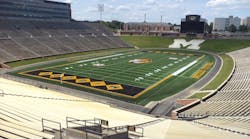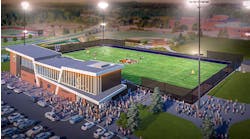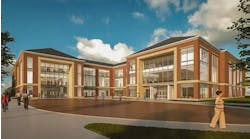For athletes, the surface on which they run, jump and tackle is as important as the lighting and facility in which they are playing. There are many choices when it comes to athletic field surfaces.
Turf Types
Turf design duplicates the bounce of the ball on natural turf, so field hockey, lacrosse, baseball, soccer and football fields will be different. Some fields, such as field hockey, require a “shock pad” underneath the surface—a more expensive proposition than sand and rubber infill used for multi-purpose fields. Football requires the longest turf blades.
Begin with an in-depth field-use audit. Is it for one or more sports, physical education, band, general recreation or more? The best selection for a multipurpose field meets several use requirements, often defaulting to the most dominant use of the field.
The most important components of turf carpet are its backing, yarn and infill. Equally important is the vendor and installer. Purchase turf only from companies that make their own product. Steer clear from suppliers that purchase and rebrand another manufacturer’s turf; often, the quality is inconsistent. Select a vendor that has been in business long enough to see through its original warranties.
Always ask upfront for a carpet sample and the number of pounds of infill included in the project bid. Schools should let the vendor know that they will calculate and check samples of both once the product delivered to the site. Only use a track or turf builder that is certified by the American Sports Builders Association.
Track Types
More than 90 percent of schools opt for polyurethane surfaces generally composed of a “black mat” with a structural spray coating. However, there are five “levels” of track quality. A latex surface is the lowest and generally not recommended. The popular “black mat” is next, followed by the “sandwich system,” which uses black mat coated with a polyurethane and chip blend.
Tied for top-quality are the “full pour” and “prefabricated” systems. A full-pour track is flooded with polyurethane and filled with chips (repeated for three layers). The prefabricated option is made offsite, like a turf carpet. It’s very expensive, Olympic-quality and often only used by NCAA Division I schools.
Other factors
When comparing turf and track, schools and universities should consider:
•Pricing. Selecting artificial turf is like purchasing carpet. Less expensive brands generally won’t last as long and may require more maintenance. When pricing, it’s important to consider durability issues.
Penn State conducted a study in November 2011 on the wear of in-filled turf. The study displays visually how 11 popular artificial turfs hold up after heavy usage (http://plantscience.psu.edu/research/centers/ssrc/documents/lisport-report.pdf).
•Durability. A turf’s life span can range from five to 12 years, depending on the type of turf installed, level of usage, quality of the base, and diligence of maintenance. Schools should factor in the cost of replacing the turf—typically about 50 to 60 percent of the original cost of the entire project. A $750,000 artificial turf can cost about $450,000 to replace if it has a properly constructed base that can be reused.
A quality track, properly installed, should have a life span of 20 years with a re-spray coating every five years and periodic base material patching every three to five years.
•Maintenance. In general, artificial turf needs to be groomed to fluff the blades. Remove debris and sweep the turf twice a month under heavy use and once a quarter with lighter use. A new rubberized track stays in good condition for five to seven years before requiring a resurfacing coat. It’s best to refer to the recommendations provided by the product manufacturer to ensure all maintenance is followed.
Taulbee is executive vice president, sports division, for Byrne & Jones, St. Louis, a leader in tennis court, running track, artificial and natural grass field construction.


